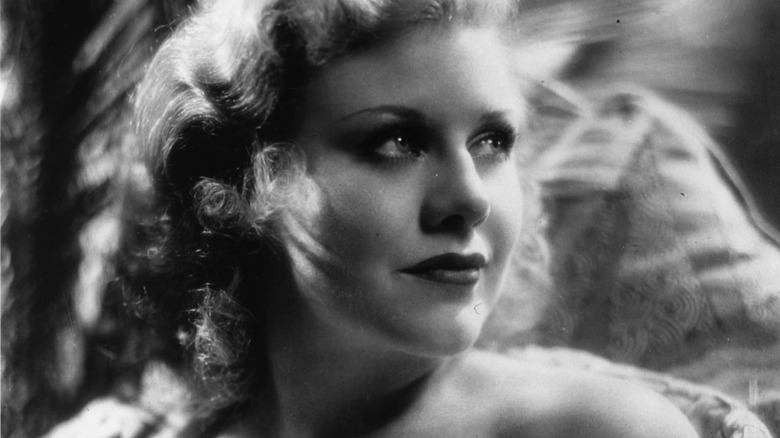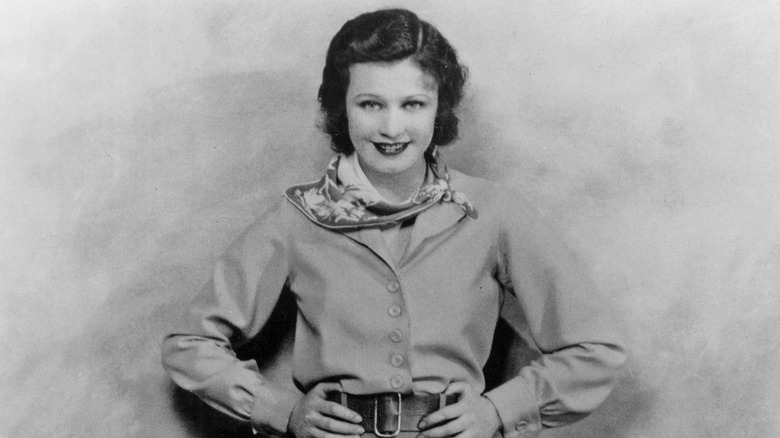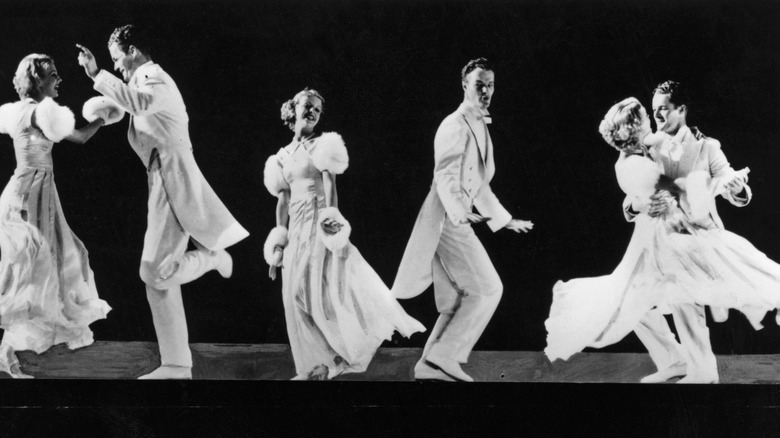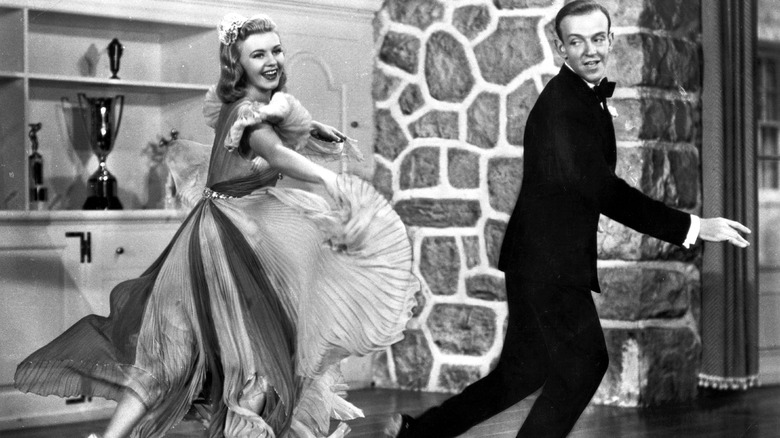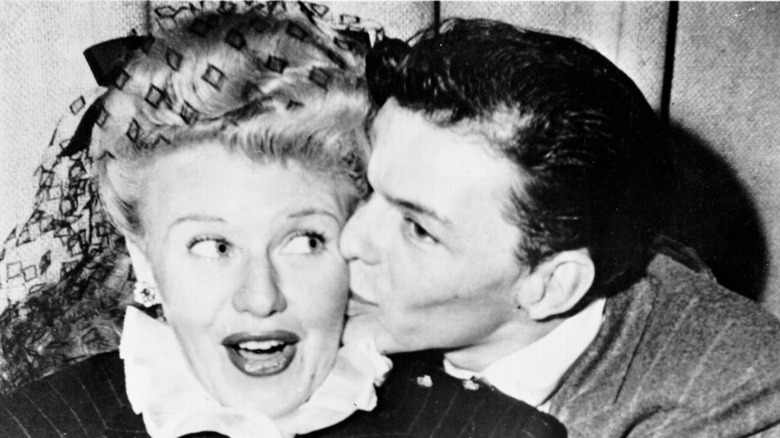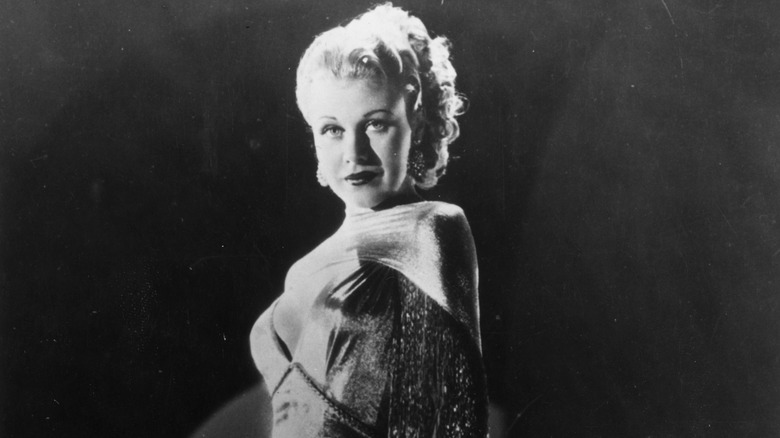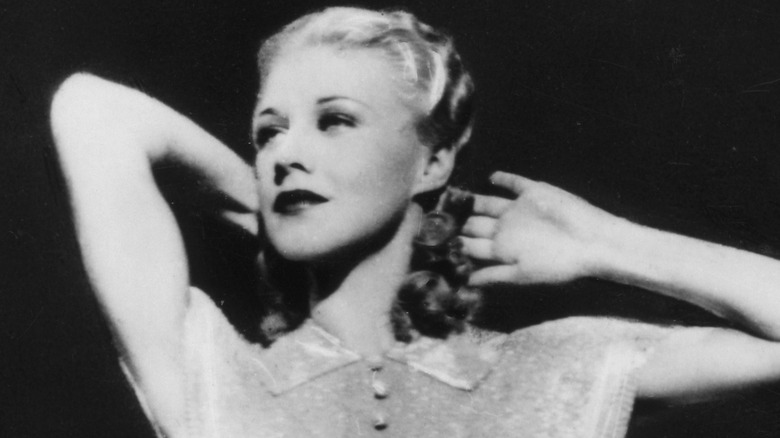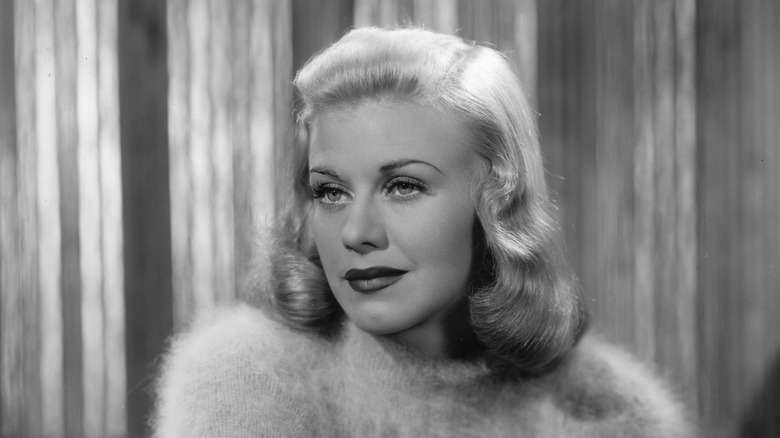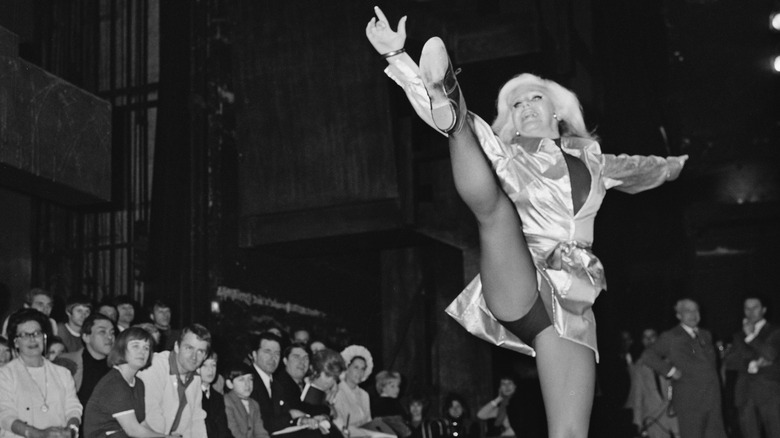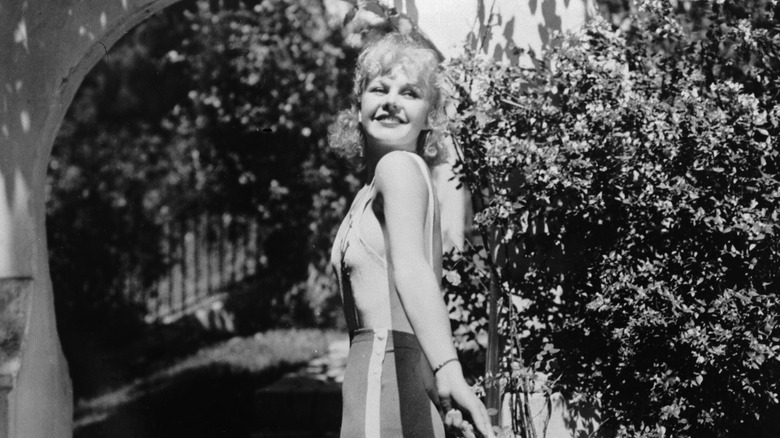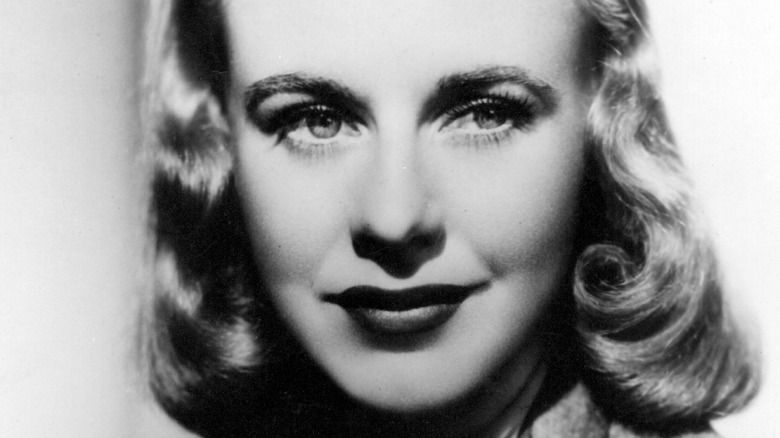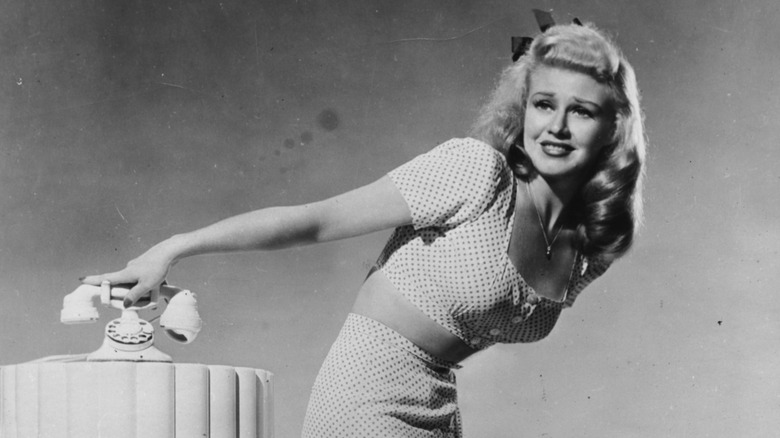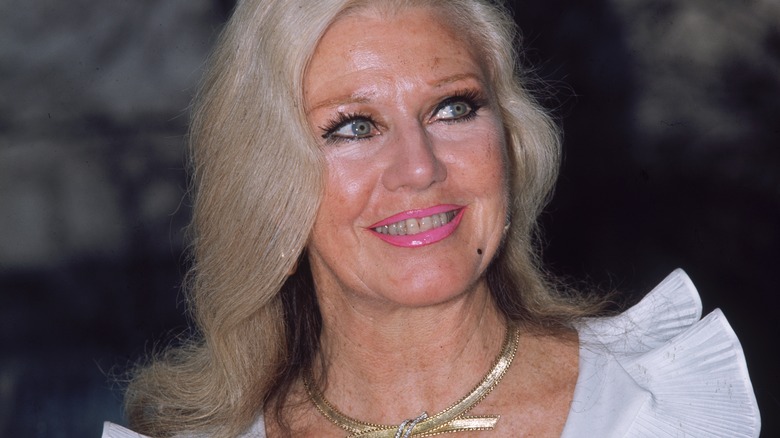The Untold Truth Of Ginger Rogers
Ginger Rogers is one of the Golden Age of Hollywood's most famous stars. The actress, dancer, and singer is largely famous for being Fred Astaire's dancing partner, but she was so much more. Rogers was an Oscar winner, a Texas Navy Admiral, and she once played at the United States Open tennis tournament. The actress had strong Christian beliefs and spent a large portion of her time relaxing at her ranch in Oregon. She loved sports and cooking.
But not everything came easy to Rogers. She literally practiced dance routines until she bled during some of her film takes with Astaire, and she experienced numerous failed marriages. But overall, Rogers' life was really good. She had passion for her work, she supported the military during World War II, and she was beloved among those who knew her best. There are many facts about her that may surprise you. Here is the untold truth of Ginger Rogers.
She got her start thanks to the Charleston
Ginger Rogers' fame had an early start and was possibly all thanks to the dance craze of the 1920s — the Charleston. As The Washington Post details, in 1925, Rogers won a dance competition in Texas. The 14-year-old wowed judges and was crowned the "Charleston Champion of Texas." Rogers would later explain that she owed her start to actor Eddie Foy Jr., who taught her the dance. Her mother had actually introduced the two of them, while reviewing vaudeville acts for the Fort Worth Record newspaper.
As the Texas State Historical Association points out, her prize for winning the competition was a vaudeville contract. With the help of her mother, "Ginger Rogers and Her Redheads" was born (via The Washington Post). While she was born Virginia Katherine McMath, according to Rogers' autobiography, "Ginger: My Story," she was known as "Ginger" because her cousin couldn't pronounce "Virginia." She ended up taking the last name of her stepfather, the only real father figure she ever had, and thus "Ginger Rogers" was born.
Rogers played vaudeville stages until 1929, eventually making her way to New York City. As Rogers details in her autobiography, she was asked to audition for a new Broadway musical, "Top Speed." She landed the role — even after she refused to do cartwheels and flips.
Ginger Rogers suffered through bleeding and whipped cream in her hair
Dancing was sometimes painful, particularly alongside Fred Astaire, who was a notorious perfectionist, writes Jeffrey Allen in "The Complete Idiot's Guide to Ballroom Dancing." While filming "Swing Time," Rogers coped with extreme foot pain. She wrote in her autobiography that she kept dancing even though her feet really hurt. At one point, she removed her shoes and they were filled with blood. "I had danced my feet raw," she explained. Producers recommended they stop filming, but Rogers wanted to complete the scene. They finally got what they wanted by 4 a.m.
In another scene, Rogers was supposed to have shampoo in her hair, which caused all sorts of problems. As she remembers in her book, they tried a variety of soaps, which ran down her face, neck, and back and didn't look right on film. They also tried egg whites and whipped cream. Despite the hardship, Rogers said the scene was "the inspiration for shampoo commercials throughout the next decade."
Astaire had a lot of confidence in his dancing partner and once remarked that the other "girls" he worked with over the years often cried because they didn't think they could make it through the routines. Rogers was the exception: "No no, Ginger never cried," he said, according to the book, "Texas Entertainers: Lone Stars in Profile," by Bartee Haile.
She nearly knocked Fred Astaire out with her beaded gown
According to NPR, in the 1936 film "Follow the Fleet," Ginger Rogers wore a stunning beaded gown that weighed over 25 pounds. Rogers likened it to the "third person" in the dance number, as per "Ginger: My Story." When she moved, the skirt followed, throwing her off balance with the momentum of the heavy dress. The twosome had to pause after she spun so the gown could settle to its original position and allow Rogers to make her next move.
The sleeves were also covered in heavy beads and had a tendency to hit Astaire in the face. Rogers admits she was "completely unaware" while she spun so quickly, never realizing her gown was causing Astaire so many problems — he winced and was forced to physically move out of the way while she kept on dancing. The director did several takes, but they couldn't come up with a workable solution, so they wound up sticking with the original shot.
She was the highest-paid Hollywood star in 1945
In addition to dancing, Ginger Rogers also had some impressive acting abilities. In 1940, she won the Best Actress Academy Award for her role in "Kitty Foyle," according to the Kennedy Center. She possessed several skills that made her a marketable and beloved star. Over the next few years, she devoted much of her time to polishing her comedy routines and working for the war effort. Like many celebrities of the time, she was prominently involved with the United States Service Organization (USO) and participated in rallies to help sell war bonds. "We were all proud to do our part," she said in her book, "Ginger: My Story." Her commitment could also have stemmed from the fact that her mother was a Marine veteran of World War I.
All of Rogers' hard work and popularity paid off (she continued making movies during her USO tours) because it resulted in the actress becoming the top-paid star in Hollywood in 1945. Her earnings were around $300,000, and she was the eighth highest money-maker in America, according to Reel Classics. Rogers was also career savvy. Willing to change with the times, she transitioned to television in the 1950s. She appeared in several comedies, dramas, and variety shows, which were popular at the time. She also returned to Broadway, replacing Carol Channing as Dolly Levi in "Hello Dolly" in 1965.
Ginger Rogers was married five times but never had children
Ginger Rogers famously dated celebrities such as Howard Hughes and Jimmy Stewart, but she was unlucky in love. She tied the knot five times, but none of them stuck, according to The Washington Post. She was just 17 years old when she married her first husband, vaudeville comedian Edward Jackson Culpepper. They split after two years together. She married her second husband, Lew Ayres, in 1934, but they divorced six years later. She also married actor Jack Briggs from 1943 to 1948, French actor Jacques Bergerac from 1953 to 1957, and actor-producer William Marshall from 1961-1970.
Rogers wrote in her autobiography, "Yes, I have had some failed marriages ... [but] I always loved being married ... being a companion with a husband [was] as natural to me as breathing." She also admitted that her life in show business made it "double hard to maintain" longevity in a relationship.
Her personal assistant of nearly 20 years, Roberta Olden, told Fox News that one of the reasons why Rogers didn't have children was because she was so busy with her career. Olden also speculated that Rogers simply didn't find the right man to have children with. And while other women gave up certain things to have children, Olden explained that Rogers enjoyed her career, so she focused on that instead.
She was commissioned as an Admiral in the Texas Navy
According to the official website of the Charles E. Hawkins Squadron, an affiliated squadron of the Texas Navy Association, the Texas Navy didn't traditionally have admirals in the 1930s. At that time, the highest naval ranks were Post Captain and Commodore. However, in 1935, film star Ginger Rogers became one of the first people to be named an Admiral by the Texas Navy. Rogers was likely the first female, or person, to be so honored with such a title, according to the Texas Navy Association.
Rogers' Texas roots can be traced back to her 1925 Charleston-winning dance competition (via the Texas State Historical Association) while she lived in Fort Worth. The San Antonio Express newspaper (via the Charles E. Hawkins Squadron) published a copy of the commissioning certificate signed by Gov. James Allred, who told reporters, "Texas is proud of Ginger ..."
"I never knew Texas had a Navy," she wrote in her autobiography, "Ginger: My Story." "Salute me, you all!"
Coincidently at the time of her commission, Rogers' movie "Follow the Fleet," alongside Fred Astaire and Randolph Scott, was set to open in theaters.
There's an alcoholic beverage named after her
Ginger Rogers was one of those rare celebrities who neither smoked nor drank alcohol, which was due to her Christian Science beliefs. She explains in her biography, "Ginger: My Story," that she "shunned alcohol," but one of her favorite beverages was, interestingly, ginger ale. She later added that she loved hosting parties but served cold drinks instead of alcohol, and one of her favorite indulgences was ice cream sodas, according to The Washington Post. Despite her aversion to alcohol, cocktail lovers can enjoy a drink specifically made in her honor. And it's no surprise, considering she is one of America's most iconic stars — there are drinks named after celebs like silent film stars Charlie Chaplin and Mary Pickford.
The Ginger Rogers is simple to concoct and a pleasant summertime cocktail. Unsurprisingly, the ingredients include gin, ginger, and ginger ale, which pay homage to the star's famous name (and her personal preferences). The recipe also includes lime juice and mint leaves.
Bartender Marcovaldo Dionysos created the Ginger Rogers in 1995 in Portland, Oregon, according to Post Prohibition. He shortly thereafter moved to San Francisco and built the bar menu at Absinthe Brasserie & Bar, where the most popular cocktail on the menu was his creation, the Ginger Rogers. He told Eater during a 2013 interview that the bar sold about 1,000 Ginger Rogers a month, and the beverage maintained its popularity over a decade later.
Her legs and movie style helped turn her into a fashion icon
Ginger Rogers had her share of fashion moments over the years. She lived during a time long before social media influencers persuaded fans how to dress. However, when Rogers wore a blue feather dress in the 1935 film, "Top Hat," feather sales skyrocketed, the actress told the New York Times in 1972. This cemented her status as a movie style icon. Then, her 1940 film "Kitty Foyle" made white-collared dresses a hot commodity, as per the New York Times.
"I can never emphasize enough how important clothing was to me," she said in her book, "Ginger: My Story." That was one of the reasons why she decided to partner with J. C. Penney in the 1970s (and surely the paycheck was another factor). From 1972 to 1975 she served as a consultant, reports the Baltimore Sun. It was a big get for the department store because it had secured one of America's most popular Golden Age stars as their spokesperson.
Rogers hand picked clothes for the mail-order catalog and traveled around the states to help women find affordable but fashionable clothing options. The star developed a wardrobe for hundreds of stores in America. Of particular interest was lingerie, as per her book.
J.C. Penney executives chose Rogers as their representative due to her fashion knowledge and because they believed her famous legs would help the company sell panty hose. The partnership made perfect sense because as a dancer Rogers had some pretty remarkable gams.
She once played at the U.S. Open tennis tournament
Some celebrity watchers may be surprised to learn that Ginger Rogers not only played tennis but was a formidable opponent. In fact, she was such a good player that in 1950, the 39-year-old actress competed at the U.S. Open in a mixed doubles match with amateur tennis player and actor Frank Shields, who today is most known for being actress Brooke Shields' grandfather, reports Oregon Live. At the time, Rogers was still a popular film star and had recently appeared with Fred Astaire in "The Barkleys of Broadway." So, it may have seemed odd that she was competing in a professional sporting event. There was reportedly some consternation over her participation due to her celebrity status. Even so, she was a skilled player who was good enough to qualify for the event.
Her former assistant, Roberta Olden, told Fox News that Rogers was a very good tennis player who always beat her even though she was decades older than she was. Rogers initially played the sport alongside Hollywood legends such as Errol Flynn and Katharine Hepburn, but she was looking for a challenge, and she certainly got it at the tournament. Unfortunately, she and Shields lost to a much younger team. Rogers also competed in a celebrity tournament that took place in conjunction with the U.S. Open, but she and her partner lost before the final match.
She owned a ranch and during WWII and supplied milk to the U.S. Army
Around 1940, Ginger Rogers purchased a ranch in southern Oregon. According to her long-time assistant Roberta Olden, she loved the ranch because it was the perfect place to relax and likely a good retreat from Hollywood (via Fox News). She spent her time there cooking, fishing, horseback riding, reading, and skeet shooting. "She would let her hair down, wear no makeup and just be a regular person. She loved that, too," Olden told Fox News. The 1,000-acre ranch was located on the Rogue River and became known as the Rogers Rogue River Ranch (4R), according to the book, "Oregon Curiosities: Quirky Characters, Roadside Oddities, and Other Offbeat Stuff," by Harriet Baskas.
The ranch was more than just a home for Rogers and her mother, who also resided there. Rogers' ranch also provided some support during the war effort. The ranch's Guernsey cows produced milk for local army men at Camp White, which was home to approximately 25,000 soldiers during World War II, as per "Oregon Curiosities." Rogers was even featured on the cover of Life Magazine in 1942, with the article inside offering a glimpse of her life there.
Rogers and her mother lived there for over half a century before the star sold the property in 1990 and moved to Medford, according to Tampa Bay Times.
Her childhood home became a museum
Ginger Rogers was born in northern Independence, Missouri, a town that in recent years has made an effort to commemorate her achievements. But it wasn't always that way, and the star felt she deserved some recognition. President Harry Truman, who spent decades living in Independence, planned a special event for Rogers in Independence in 1964 after she complained that the residents celebrated his May birthday but didn't commemorate hers, according to The Examiner. Rogers was also honored at an event in town in 1994.
The actress, who passed away in 1995, likely would have been pleased that in 2018, her former home, a registered historic landmark, was officially turned into the Ginger Museum. Rogers and her mother lived on the property for four years, and the home was restored so it looked like it did when they resided there. The property also became the site of the Ginger Festival that year, which celebrated the life of the Hollywood icon. The money raised during the festival was allocated towards repairing the home's roof and upgrading the landscaping. The festival included the presentation of two Ginger Roger films, a fan club meeting, and presentations about the house, according to PR.com. Unfortunately, the museum closed in 2020 due to the COVID-19 pandemic, as per the museum's website.
Ginger Rogers was a Christian Scientist
Ginger Rogers' mother raised her as a Christian Scientist, according to Fox News, and the religion was a huge part of her life. One of the ways in which she practiced her faith was by living a clean life without alcohol and avoiding the temptations that Hollywood had to offer. Her religion and relationship with God was part of her life both on screen and off. Her longtime assistant, Roberta Olden, told Crosswalk.com that her faith was very important, and "she knew that it was God's gift of goodness that shone through [her performances]." And, truly, Rogers' dancing and acting skills were quite good, so it's not difficult to believe that they may have been a gift from above.
However, it wasn't always easy for Rogers to avoid the pressures of the industry. Privacy was difficult to attain because she was so famous, and not everyone understood her Christian beliefs, as per Crosswalk.com. Plus, she endured several failed marriages and had other struggles that could have caused some people to quit Hollywood. Instead, Rogers took refuge in her church and through prayer. Olden explained, "I don't think there was a day that went by when she didn't thank God for something."
